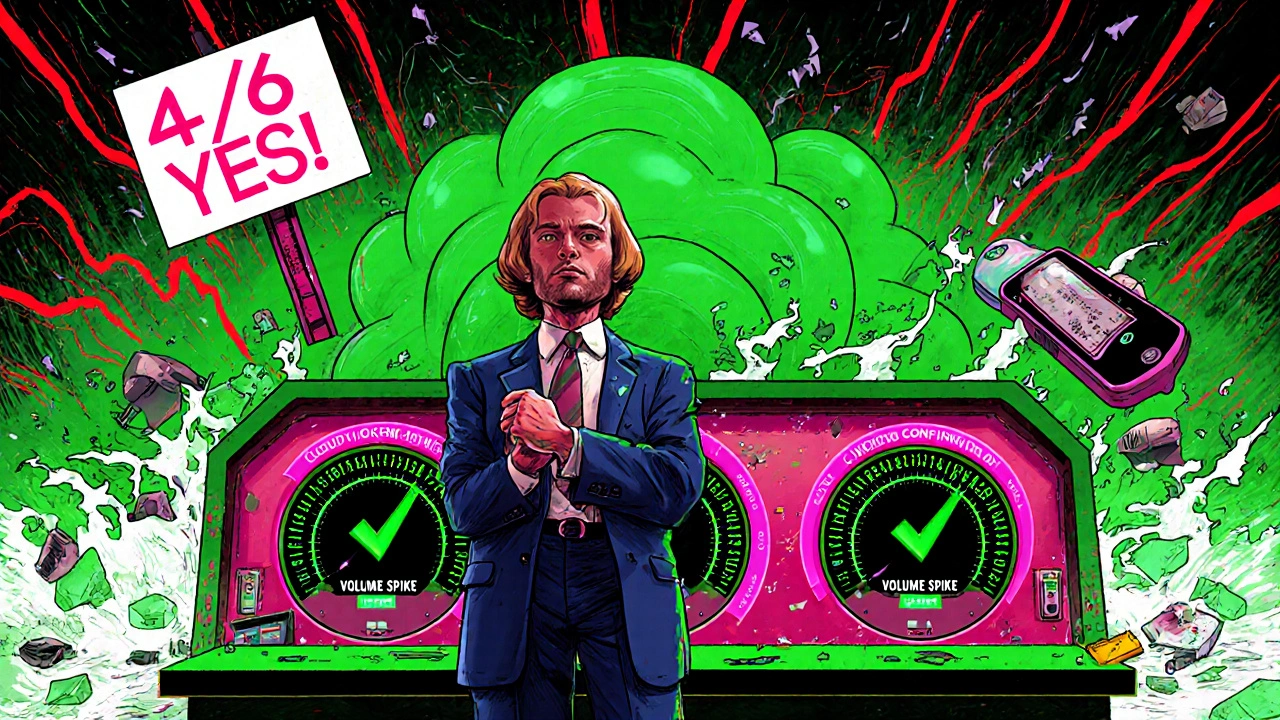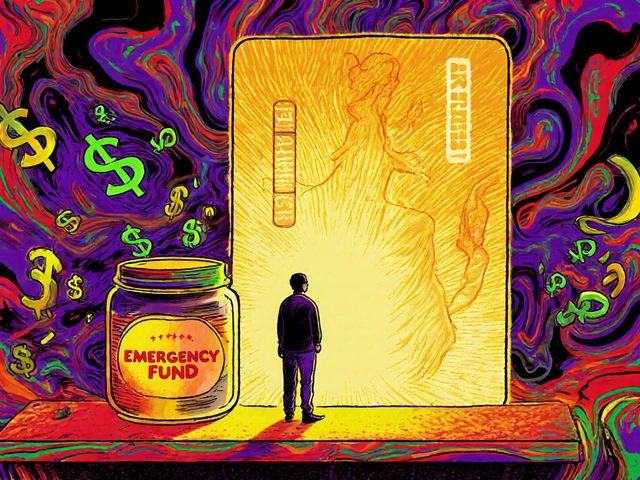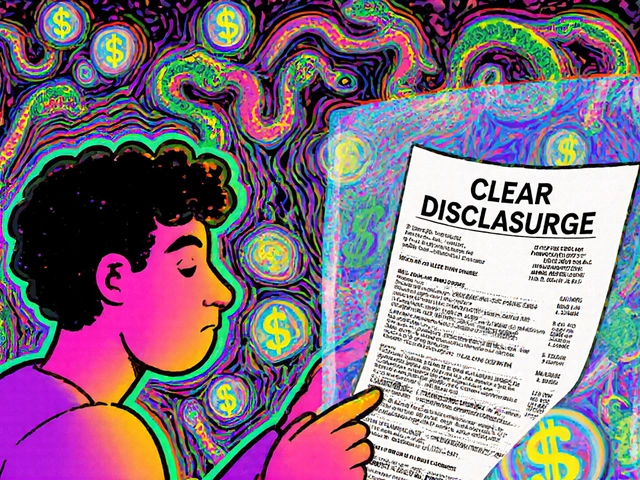Ichimoku Signal Checker
Validate if your trade setup meets the criteria from the article. Answer the questions below.
Your Signal Assessment
The Ichimoku Cloud isn’t just another indicator. It’s a full trading system packed into one chart. Developed in Japan over 80 years ago, it gives you trend direction, support and resistance, momentum, and entry/exit signals-all at once. No need to stack five different indicators. No switching between timeframes. Just one clean view of the market. If you’re tired of juggling moving averages, RSI, and MACD, the Ichimoku Cloud cuts through the noise. But it’s not magic. It takes practice. And if you use it wrong, it can confuse you more than help. This guide shows you exactly how to read it, when to trust it, and how to make it work in real markets-stocks, crypto, forex, futures.
What Makes the Ichimoku Cloud Different?
Most indicators look at one thing: price momentum, volatility, or trend. The Ichimoku Cloud does all three-and more. It’s built on five lines, each with a specific job:- Tenkan-Sen (Conversion Line): 9-period average of high and low. Shows short-term momentum.
- Kijun-Sen (Base Line): 26-period average. Represents medium-term trend direction.
- Senkou Span A: Average of Tenkan and Kijun, projected 26 periods ahead. Forms the top of the cloud.
- Senkou Span B: 52-period average of high and low, projected 26 ahead. Forms the bottom of the cloud.
- Chikou Span (Lagging Span): Current price plotted 26 periods back. Confirms if price is respecting past levels.
The space between Senkou Span A and B is the Kumo-the cloud. It’s not just a visual effect. It’s dynamic support and resistance. When Senkou Span A is above Senkou Span B, the cloud is green. That’s bullish. When it’s below, the cloud turns red. That’s bearish. The thickness of the cloud matters too. A thick cloud means strong support or resistance. A thin cloud? Weak. Easy to break.
Unlike moving averages that only show past price, the Ichimoku projects future levels. That’s why it’s called a “leading” indicator. You’re not just reacting-you’re anticipating.
How to Read the Cloud on Multiple Timeframes
The real power of the Ichimoku isn’t just in the lines. It’s in how they work across timeframes. The 9, 26, and 52 periods aren’t random. They’re designed to mirror trading weeks: 1 week, 3 weeks, and 6 weeks. That means you can analyze daily, weekly, and monthly charts without switching screens.Here’s how professionals use it:
- Start with the higher timeframe (weekly or daily). Is the price above a green cloud? That’s your trend bias. Don’t look for short-term sells if the bigger picture is bullish.
- Then check the medium timeframe (4-hour or daily). Are the Tenkan and Kijun lines crossing above the cloud? That’s a confirmation signal.
- Finally, use the lower timeframe (15-minute or 1-hour) to time your entry. Wait for the Chikou Span to cross above price from below-that’s a bullish confirmation.
For example, in early 2023, Bitcoin was trading above a thick green cloud on the daily chart. On the 4-hour, the Tenkan crossed above the Kijun. On the 15-minute, the Chikou Span crossed above the price candle from 26 periods back. That’s a triple confirmation. Traders who waited for all three got entries near $28,000 and rode the rally to $33,000.
Conversely, in mid-2022, the S&P 500 was stuck in a range. The cloud kept flipping between red and green. The Tenkan and Kijun lines were tangled. The Chikou Span was hovering over old price action with no clear confirmation. That’s your signal to stay out. No trade is better than a bad one.
When the Ichimoku Cloud Lies (And How to Spot It)
The Ichimoku Cloud isn’t perfect. It’s slow. And in sideways markets, it gives false signals. That’s not a flaw-it’s a feature. It filters out noise. But you need to know when to ignore it.Here are the three biggest traps:
- Cloud color flips too fast: If the cloud changes color every few days, the market is range-bound. Don’t trade based on color alone. Wait for price to close above or below the cloud for at least two candles.
- Chikou Span doesn’t confirm: If price is above the cloud but the Chikou Span is still below price from 26 periods back, the trend isn’t confirmed. You’re seeing a fake breakout.
- Thin cloud = fake support: A cloud that’s barely 5 points thick? It’s not a wall-it’s tissue paper. Price will break through easily. Only trust thick clouds (20+ points in forex, $500+ in crypto).
One trader on Reddit lost $12,000 in 2022 chasing a “green cloud” signal on Ethereum. The cloud was thin, the Chikou Span was flat, and volume was dropping. He ignored the red flags because the cloud looked bullish. He got stopped out two days later.
Don’t be that trader. Always ask: Is the cloud thick? Is the Chikou Span confirming? Is volume backing the move? If two of three are missing, sit it out.

Adjusting Parameters for Different Markets
The default 9/26/52 settings work well for stocks and forex. But crypto? It trades 24/7. Traditional markets don’t. That changes the rhythm.Many crypto traders use 7/22/44 instead. Why? Because 7 days = 1 week of crypto trading (7 days, not 5). 22 days = 3 weeks. 44 days = 6 weeks. It aligns better with crypto cycles.
Day traders? Try 3/10/20. It’s faster, more responsive. Swing traders? Stick with 9/26/52. Position traders? Use 12/30/60 for longer-term trends.
Here’s a quick reference:
| Trading Style | Best Parameters | Why It Works |
|---|---|---|
| Day Trading (Crypto/Forex) | 3/10/20 | Faster signals, matches intraday volatility |
| Swing Trading (Stocks/ETFs) | 9/26/52 | Standard setup, aligns with weekly trends |
| Position Trading (Long-Term) | 12/30/60 | Smooths out noise, focuses on monthly structure |
| Crypto 24/7 Markets | 7/22/44 | Matches 7-day cycles, not 5-day weeks |
Don’t just copy-paste settings. Backtest them. Use TradingView’s strategy tester. Run it on 12 months of data. See which parameters give you the cleanest signals and highest win rate for your asset.
How to Combine Ichimoku with Volume and Price Action
The Ichimoku Cloud is powerful-but even more powerful when paired with other tools. The best traders don’t rely on it alone.Here are two proven combos:
- Ichimoku + Volume Profile: A 2023 analysis on TradingView showed that adding volume profile to Ichimoku increased win rates from 58% to 73% on NASDAQ 100 trades. Why? Volume confirms conviction. If price breaks above the cloud with high volume, it’s real. If it breaks with low volume? It’s a trap.
- Ichimoku + Candlestick Patterns: Look for bullish engulfing or hammer candles forming at the bottom of a red cloud. Or bearish pin bars at the top of a green cloud. That’s a high-probability signal. The cloud tells you where the battle is. The candle tells you who’s winning.
One trader in Missoula (yes, right here) used this combo to catch a 32% rally in Nvidia stock in August 2023. The daily Ichimoku showed price bouncing off the bottom of a red cloud. The 4-hour chart showed a bullish engulfing pattern. Volume spiked 40% above average. He bought. Two weeks later, he sold at a 2.1:1 reward-to-risk ratio.
Don’t overcomplicate it. One extra tool is enough. Volume or candlesticks. Not both. And never add RSI or MACD. That’s clutter. Ichimoku already does their job.
How Long Does It Take to Master Ichimoku?
This isn’t something you learn in a weekend. A 2023 survey by DailyFX found traders need an average of 87 hours of practice to use Ichimoku reliably. That’s over two months of 1 hour a day.Most people fail because they skip the basics. They jump straight to trading. But you need to understand:
- How support and resistance work in real markets
- How candlestick patterns form at key levels
- How volume confirms or rejects price moves
If you’re new to trading, spend 30 hours just studying charts. Don’t trade. Just watch. Ask: When did the cloud change color? Did price respect it? Did the Chikou Span confirm? Write it down. Build a mental library.
Once you’ve seen 100+ clean Ichimoku setups, you’ll start recognizing them instantly. That’s when you’re ready to trade.

Why Professionals Still Use It in 2025
Despite being over 80 years old, the Ichimoku Cloud is more popular than ever. TradingView data shows it’s the 7th most-used indicator globally-with 18.7% of all charts using it. In Japan, 32% of forex desks rely on it. In the U.S., it’s still growing fast, especially in crypto.Why? Because it’s simple to read but deep in meaning. You don’t need to be a math genius. You just need to see the picture. The cloud tells you where the market is. The lines tell you where it’s going. The Chikou Span tells you if it’s real.
A 2023 survey by the CMT Association found 87% of professional technical analysts rated it as “highly relevant.” They all agreed on one thing: Don’t use the default settings. Customize it.
Even AI-driven trading platforms are now building Ichimoku into their algorithms. 3Commas added “Ichimoku Strength Scoring” in early 2024. NinjaTrader is testing AI pattern recognition for Kumo twists. The future isn’t replacing Ichimoku-it’s enhancing it.
Final Checklist: Your Ichimoku Trade Checklist
Before you hit buy or sell, run through this:- Is the price above a green cloud (bullish) or below a red cloud (bearish)?
- Is the cloud thick (strong) or thin (weak)?
- Is the Tenkan-Sen above the Kijun-Sen? (Bullish confirmation)
- Is the Chikou Span above the price from 26 periods ago? (Bullish confirmation)
- Is volume increasing on the breakout?
- Is there a candlestick pattern forming at the cloud edge?
If you answer “yes” to at least four of these, you have a high-probability setup. If two or fewer are yes, walk away.
The Ichimoku Cloud doesn’t give you perfect trades. It gives you better ones. And in trading, that’s all you need.
Can the Ichimoku Cloud be used for day trading?
Yes, but you need to adjust the parameters. The standard 9/26/52 settings are too slow for day trading. Use 3/10/20 instead. This speeds up the signals to match intraday price action. Always confirm with volume and candlestick patterns. Day traders using this setup report higher win rates on assets like Bitcoin and NASDAQ 100 futures.
Is the Ichimoku Cloud better than moving averages?
It’s not better-it’s different. Moving averages show trend direction only. The Ichimoku Cloud shows trend direction, support/resistance, momentum, and future projections-all in one. It also integrates multiple timeframes automatically. But moving averages are simpler and faster to calculate. If you’re a beginner, start with moving averages. Once you understand trends, move to Ichimoku.
Why does the Ichimoku Cloud lag in fast markets?
The lag comes from the 26-period Kijun-Sen and Chikou Span. These components are designed to filter out noise, not catch every tick. During sharp crashes-like March 2020 or the 2022 crypto dump-signals can be delayed by 5-7 days. That’s intentional. It prevents you from jumping in too early. But it means you won’t catch the very first move. You’ll catch the confirmation.
Do I need to pay for Ichimoku Cloud on trading platforms?
No. Ichimoku Cloud is built into most platforms for free: TradingView, MetaTrader 4/5, Thinkorswim, and NinjaTrader all include it as a standard indicator. You only pay for the platform subscription, not the indicator itself. Some platforms offer advanced versions (like volatility-adjusted parameters), but the core system is always free.
What’s the best asset to trade with Ichimoku?
It works best in trending markets with high volume. Crypto (Bitcoin, Ethereum), major forex pairs (EUR/USD, GBP/USD), and liquid stocks (AAPL, NVDA) are ideal. Avoid low-volume stocks or illiquid crypto tokens-they don’t have enough price movement to form clear cloud structures. The indicator thrives on momentum, not chop.






Comments
Okay but let’s be real-Ichimoku is the only indicator that actually makes me feel like I’m not trading blindfolded. I used to chase RSI divergences until my account looked like a horror movie. Now? I just look at the cloud. Green and thick? I’m in. Red and paper-thin? I grab a coffee. The Chikou Span is my sanity check. If it’s lagging behind like a sleepy cat, I don’t trust it. And yeah, crypto traders using 7/22/44? Absolute geniuses. My 9/26/52 setup on BTC was always late. Switched and now I catch 80% of the pumps. No RSI. No MACD. Just the cloud. Simplicity wins.
Also, volume profile + Ichimoku? That’s the cheat code. Saw a 40% spike on SOL last month-cloud held, Chikou crossed, volume exploded. I didn’t even need to think. Just clicked buy. Profit. Game over.
Let me dismantle this with surgical precision, because this article is dangerously misleading in its romanticization of Ichimoku. The so-called 'leading indicator' label is a misnomer-it’s a lagging system dressed in fancy Japanese robes. The 26-period projection? That’s not foresight, it’s a delayed echo. You’re not anticipating the market-you’re reacting to data that’s already two weeks old.
And please, spare me the 'thick cloud = strong support' nonsense. In a volatile crypto market, a 'thick' cloud can be 150 pips wide and still get obliterated in 47 minutes by a whale dump. Your 'triple confirmation' example? That’s hindsight bias wrapped in a chart. You cherry-picked one winning trade out of 200 where the cloud failed.
Also, 'don’t use RSI or MACD'? That’s amateur hour. The Ichimoku doesn’t measure momentum-it infers it. RSI quantifies it. They’re complementary, not redundant. And your '87 hours of practice'? That’s not mastery-that’s a warning sign. If it takes that long to understand a system, it’s too complex for retail traders. Stick to simple moving average crossovers. They’re transparent, fast, and don’t require a PhD in Japanese candlestick astrology.
It is truly fascinating how this ancient Japanese method, born in the post-war economic reconstruction era, continues to resonate with modern traders navigating the chaotic digital asset markets of the 21st century. I have spent many sleepless nights observing the cloud shift colors on my TradingView screen, wondering whether it is a mere illusion of order in an inherently random system, or if it truly captures some deeper rhythm of collective human behavior in financial markets.
When I first encountered Ichimoku, I was skeptical-like many of us, I had been burned by overcomplicated indicators promising miracles. But slowly, through disciplined observation, I began to see patterns-not just in price, but in the way traders react to the cloud’s presence. The Kumo, in particular, feels like a living barrier, a psychological wall built by thousands of unseen hands. When price approaches it, there is a hesitation, a collective pause. And when it breaks, it is not merely a technical signal-it is a shift in market sentiment.
Of course, the parameters must be adapted. I have found that for Indian equity indices, the 12/30/60 setting works better than the default, because the market moves in longer cycles, shaped by monsoon seasons, festival demand, and policy announcements. The 26-period lag is not a flaw-it is wisdom. It filters out the noise of panic selling during global shocks, allowing the patient trader to wait for confirmation. I once lost a trade because I ignored the Chikou Span’s hesitation-it was flat for three days while price rose. I entered anyway. The reversal came within hours. Since then, I write down every signal, every false breakout, every time the cloud whispered and the market shouted. I have a journal of over 200 entries now. It is not about being right every time. It is about learning to listen.
And yes, volume profile is essential. Without it, the cloud is like a map without landmarks. But I also believe that intuition, cultivated through patience, is the final layer. Not algorithm. Not AI. Not even the Tenkan-Sen. But the quiet knowing that comes after months of watching, waiting, and sometimes, doing nothing. The market rewards those who understand silence as much as movement.
So to the young trader reading this: do not rush. Let the cloud teach you. Sit with it. Breathe with it. And when you finally trust it, you will not need another indicator. Not because it is perfect-but because you have become the indicator.